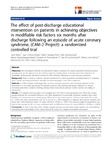Mostrar o rexistro simple do ítem
The effect of post-discharge educational intervention on patients in achieving objectives in modifiable risk factors six months after discharge following an episode of acute coronary syndrome, (CAM-2 Project): a randomized controlled trial
| dc.contributor.author | Muñiz, Javier | |
| dc.contributor.author | Gómez Doblas, Juan José | |
| dc.contributor.author | Santiago-Pérez, M.I. | |
| dc.contributor.author | Lekuona-Goya, Iñaki | |
| dc.contributor.author | Murga-Eizagaetxebarría, Nekane | |
| dc.contributor.author | Teresa Galván, Eduardo de | |
| dc.contributor.author | Cruz Fernández, José María | |
| dc.contributor.author | Castro-Beiras, Alfonso | |
| dc.date.accessioned | 2015-09-18T11:30:54Z | |
| dc.date.available | 2015-09-18T11:30:54Z | |
| dc.date.issued | 2010-11-22 | |
| dc.identifier.citation | Muñiz J, Gómez-Doblas JJ, Santiago-Pérez MI, Lekuona-Goya I, Murga-Eizaetxeberría N, Teresa-Galván E, et al. The effect of post-discharge educational intervention on patients in achieving objectives in modifiable risk factors six months after discharge following an episode of acute coronary syndrome, (CAM-2 Project): a randomized controlled trial. Health Qual Life Outcome. 2010;8:137 | es_ES |
| dc.identifier.uri | http://hdl.handle.net/2183/14990 | |
| dc.description.abstract | [Abstract] Objectives. We investigated whether an intervention mainly consisting of a signed agreement between patient and physician on the objectives to be reached, improves reaching these secondary prevention objectives in modifiable cardiovascular risk factors six-months after discharge following an acute coronary syndrome. Background. There is room to improve mid-term adherence to clinical guidelines' recommendations in coronary heart disease secondary prevention, specially non-pharmacological ones, often neglected. Methods. In CAM-2, patients discharged after an acute coronary syndrome were randomly assigned to the intervention or the usual care group. The primary outcome was reaching therapeutic objectives in various secondary prevention variables: smoking, obesity, blood lipids, blood pressure control, exercise and taking of medication. Results. 1757 patients were recruited in 64 hospitals and 1510 (762 in the intervention and 748 in the control group) attended the six-months follow-up visit. After adjustment for potentially important variables, there were, between the intervention and control group, differences in the mean reduction of body mass index (0.5 vs. 0.2; p < 0.001) and waist circumference (1.6 cm vs. 0.6 cm; p = 0.05), proportion of patients who exercise regularly and those with total cholesterol below 175 mg/dl (64.7% vs. 56.5%; p = 0.001). The reported intake of medications was high in both groups for all the drugs considered with no differences except for statins (98.1% vs. 95.9%; p = 0.029). Conclusions. At least in the short term, lifestyle changes among coronary heart disease patients are achievable by intensifying the responsibility of the patient himself by means of a simple and feasible intervention. | es_ES |
| dc.language.iso | eng | es_ES |
| dc.publisher | BioMed Central | es_ES |
| dc.relation.uri | http://www.biomedcentral.com/content/pdf/1477-7525-8-137.pdf | es_ES |
| dc.rights | Creative Commons Licence | es_ES |
| dc.rights | Reconocimiento 4.0 Internacional | |
| dc.rights.uri | http://creativecommons.org/licenses/by/4.0/ | |
| dc.title | The effect of post-discharge educational intervention on patients in achieving objectives in modifiable risk factors six months after discharge following an episode of acute coronary syndrome, (CAM-2 Project): a randomized controlled trial | es_ES |
| dc.type | info:eu-repo/semantics/article | es_ES |
| dc.rights.access | info:eu-repo/semantics/openAccess | es_ES |
Ficheiros no ítem
Este ítem aparece na(s) seguinte(s) colección(s)
-
GI- GRINCAR - Artigos [216]






